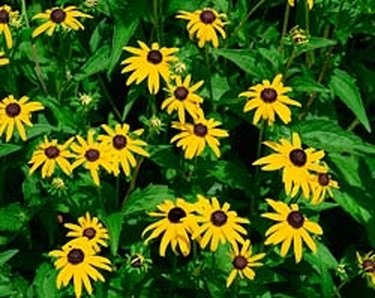
This great wildflower of North America is among the famous group of wildflowers that inhabit the prairies. The Black Eyed Susans were the first to become domesticated garden flowers. Showy flowers brighten summer and fall beds. They are good cut flowers that will rebloom late in season after earlier cutting. They are excellent in sunny borders, mixed with clumps of ornamental grasses, or naturalized in meadows.
Step 1
Most perennials (including Black-eyed Susans) should be divided every three years.Divide these plants with a spade or pitchfork one can cut the plant ball into several pieces as long as there are significant roots
Video of the Day
Step 2
Dig up the clump in the Autumn, at least 30 days before the first frost,
Step 3
remove any dead or woody material
Step 4
Divide these plants with a spade or pitchfork one can cut the plant ball into several pieces as long as there are significant roots
Step 5
Dig a hole for each divided section in the new location. Be sure that each hole is larger than the root system of each division.
Step 6
Place a clump of Black-eyed Susans in the newly dug hole.
Step 7
Cover the roots with soil. Be sure to press the soil down firmly in order to eliminate any air pockets.
Step 8
Water the Black-eyed Susan thoroughly. Be sure to keep the divided plants watered unti they are established.
Tip
A good rule of thumb to follow for transplanting perennials is if they bloom in the fall, divide and transplant them in the spring. If they bloom in the spring, divide and transplant them in the fall. Rudbeckia will thrive in all but soggy soil. Some species prefer soil that is fertile and moist while others will grow in drier soil. All prefer well-drained soil. Rudbeckia like full sun and thrive when planted where they can get full sun all day.Rudbeckia have a long blooming period from early summer to frost. This makes them an invaluable addition to the late summer garden. Dead-heading or cutting back will encourage the plant to re-bloom later in the season.
Warning
Rudbeckia are bothered by the following pest: Asiatic garden beetle, crescent marked lily aphid, flea hopper, four lined plant bug, Fuller rose beetle, sawflies, stalk borer, two spotted spider mites and white flies. Rudbeckia are susceptible to downy mildew, powdery mildew, rust, stem rot, wilt, Aster yellow, and leaf spot (Alternaria, Cercospora, Colletotrichum, Phyllosticta or Septoria spp.).
Video of the Day